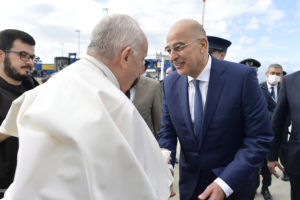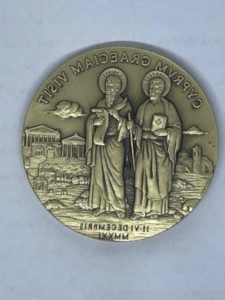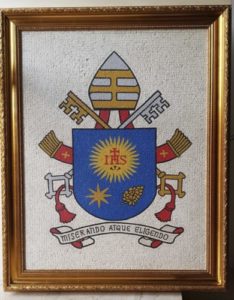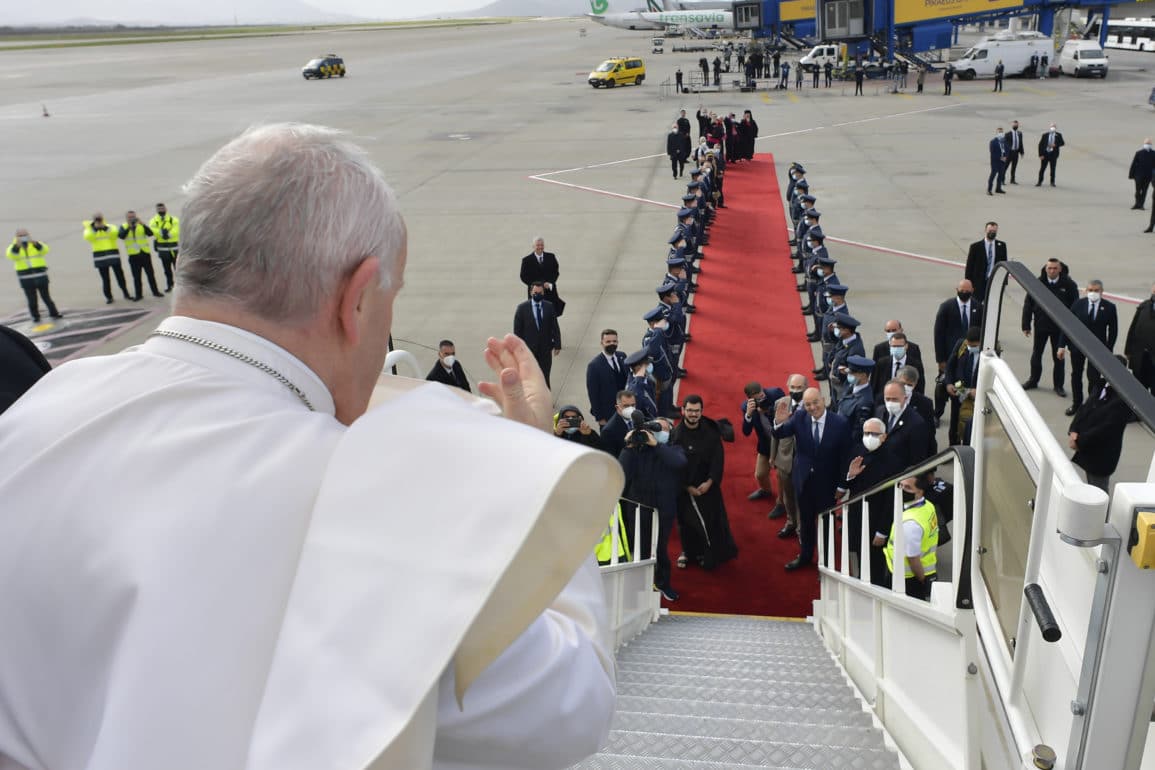Pope Francis has returned to Rome, ending his 35th Apostolic Journey to Cyprus and Greece. Exaudi was present on the papal flight.
Pope Francis left Greece today, December 6, 2021, where he arrived last December 4 from Larnaca, Cyprus.
Farewell at the Airport

After presiding over the meeting with young people in the school of Saint Dionysius of the Ursuline Sisters of Athens, the Pontiff went to the airport of the Greek capital by car for a farewell ceremony. He was received by the Foreign Affairs Minister, who accompanied him to the airport’s VIP lounge, where they held a private meeting that lasted a few minutes.
After going through the Guard of Honour and greeting the delegations, the Bishop of Rome boarded the plane at 11:55 am (10:55 in Rome). After flying for some 2:05 hours over 2,100 kilometers, the plane landed in Rome’s Ciampino airport around 12:35 (local time).
On this trip to Greece, Pope Francis met in Athens with the President of the Republic, Katerina Sakellaropoulou and the Authorities; with the Catholic community, Bishops, priests, men and women religious, seminarians and catechists, and with Ieronymos II, leader of the Orthodox Church on two occasions. He also went for the second time to the Island of Lesbos to visit the refugees and celebrated the Mass of the Second Sunday of Advent in Athens. Before leaving the country, the Holy Father received the President of the Parliament in the Apostolic Nunciature and had one last meeting with young people.
Telegram to the President of the Republic
Immediately after his departure by plane from Athens, the Holy Father sent the following telegram to the President of the Hellenic Republic, Katerina Sakellaropoulou.
“On leaving Greece, I express my profound gratitude to Your Excellency and to all the people of the Hellenic Republic for their kind hospitality during my Apostolic visit. While assuring you of my prayers, I invoke God’s blessings on the nation.”
The Holy Father’s Addresses in Greece
Pope Francis gave six addresses, one homily, and prayed the Angelus in the Hellenic country. During the Mass in Athens’ Megaron Concert Hall, he recalled the Catholic faithful in Greece, a minority group, saying that “the Lord prefers littleness and humility,” and he asked them not to “fear littleness because the issue isn’t about being small and few, but about opening oneself to God and to others, adding that they shouldn’t be afraid of aridity, because God doesn’t fear it, and it’s in aridity that He comes to visit us.”
In the Lesbos Refugee Center he said: “I’m here again to meet with you; I’m here to tell you that I’m close to you; I’m here to see your faces, to look at you in your eyes, eyes full of fear and hope, eyes that have witnessed violence and poverty, furrowed eyes by too many tears.”
And he stressed that migration “is a problem of the world,” a humanitarian crisis “that concerns all.” The pandemic “affected us globally, it has made us feel we are all in the same boat, it has made us experience what it means to have the same fears. We have understood that the great questions are faced together because in today’s world fragmented solutions are inadequate,” he continued.
On the ecumenical plane, during the meeting with the Orthodox Archbishop of Athens and All Greece and their respective entourages, he stressed the “apostolic roots that both Churches share” and he lamented that “then we grew apart: we were contaminated by mortal poisons, the tares of suspicion increased the distance, and we ceased to cultivate communion.”
He also expressed “with shame — acknowledging it for the Catholic Church –, of actions and decision that had little or nothing to do with Jesus and His Gospel, based rather on the thirst for gains and power, which withered communion” and “we have let fecundity be threatened by divisions.” “History has its weight and here, today, I feel the need to renew the supplication of forgiveness to God and to brothers for the errors committed by so many Catholics,” he admitted.
In Ieronymos II’s visit at the Apostolic Nunciature, the Pontiff thanked him for his fraternal kindness, “his meekness, his patience” and he hoped “that the Lord will give us the grace to continue together on this path of fraternity and peace.”
In his address to the Catholic community, in the Cathedral of Saint Dionysius of Athens, he invited us to allow ourselves to be oriented “in our journey as Church by two attitudes of the Apostle (Paul), which are useful for our present elaboration of the faith”: trust and welcome, and he explained that “to be a small Church makes us an eloquent sign of the Gospel, of the God, proclaimed by Jesus who chooses the little ones and the poor, who changes history with the simple feats of the humble.” As Church, “we are not asked for the spirit of conquest and of victory, the magnificence of great numbers, worldly splendor, but that “we be leaven that ferments hiddenly, patiently and silently, in the dough of the world, thanks to the incessant work of the Holy Spirit.”
In the case of the Greek Authorities, the Bishop of Rome expressed his gratitude for their “commitment,” and exhorted them to have Greece progress “in openness, inclusion, and justice.” He also exhorted them to “respond to the seductions of authoritarianism with democracy; that they oppose individualist indifference with care of the other, of the poor and of creation, essential pillars for a renewed humanism, which is what our time and our Europe need.”
Gifts to the Nunciature

The trip’s medal represents the two Apostles, Paul and Barnabas, essential figures in the evangelization of these lands. Saint Barnabas is on the left, with the Gospel in one hand and a staff in the other, symbols of his pilgrimage to proclaim the Word. We can recognize the church Chrysopolitissa of Paphos, which expresses symbolically the long history of Christianity in Cyprus and which today is a place of encounter of the different Christin denominations.
The Apostle Paul is on the right, with a pen and parchment, writing his famous Epistles. Behind him is a symbolic view of ancient Greece, as it is Greece that the Apostle Paul traveled through and evangelized. His meeting in Athens’ Areopagus is famous in this connection.
Made entirely in mosaic through the traditional technique of hand cutting and placement of each of the colored tiles, this panel represents the Coast of Arms of His Holiness Pope Francis.

The acronym IHS stands for Iesus Hominum Salvator (Jesus, Saviour of Humanity), or In Hoc Signo (Vinces), of Constantine memory. Later the Jesuits interpreted it as Habemus Iesum Socium (We have Jesus as companion) and Societas Iesus Humilis (Humble Society of Jesus). In addition to the symbol of the Society of Jesus, there is also a star that, according to heraldic tradition, symbolizes the Virgin Mary and the flower of the nard, which in Hispanic iconography makes reference to Saint Joseph’s chastity.
With the choice of these symbols for his Coat of Arms, Pope Francis wished to express not only his particular devotion to the Holy Name of Jesus and his belonging to the Jesuits but also his devotion to the Virgin Mary and to Saint Joseph, her husband.
The motto that accompanies Pope Francis’ Coat of Arms — Misrerando atque eligendo — pays homage instead to the Divine Mercy. It is taken from the Homilies of Saint Bede the Venerable who, commenting on the evangelical episode of Saint Matthew’s calling, wrote “Vidi ergo Iesus publicanum et quia miserando atque eligendo vidit, ait illi Sequere me” (“Jesus saw a tax collector and, looking at him with a sentiment of love and choosing him, said to him: “me”).
Translation by Virginia M. Forrester










